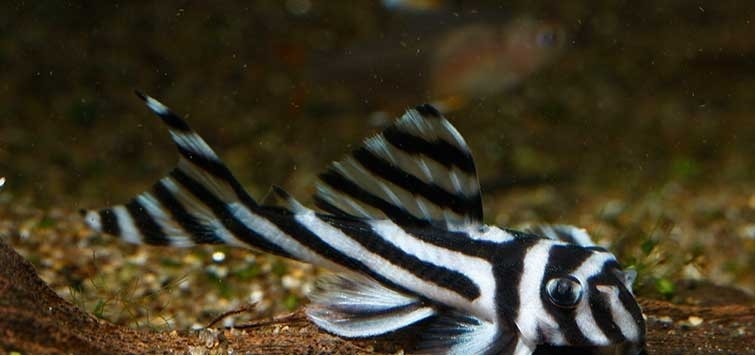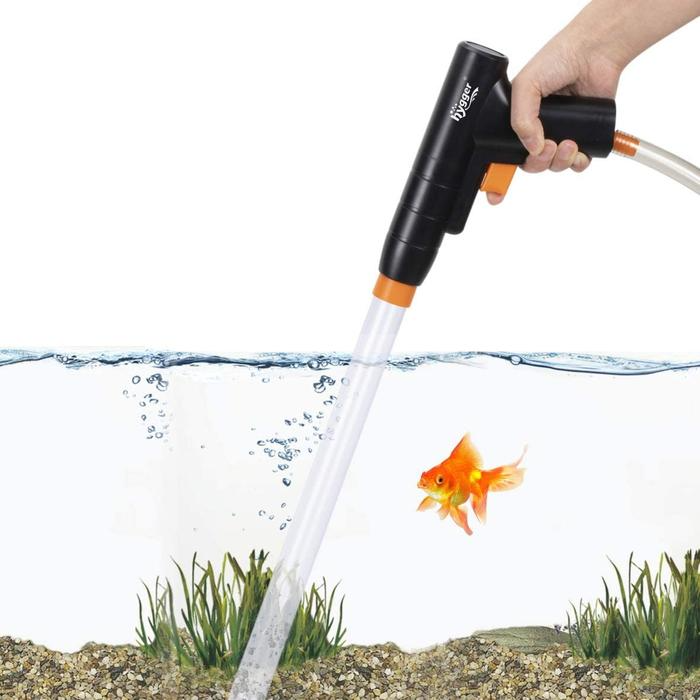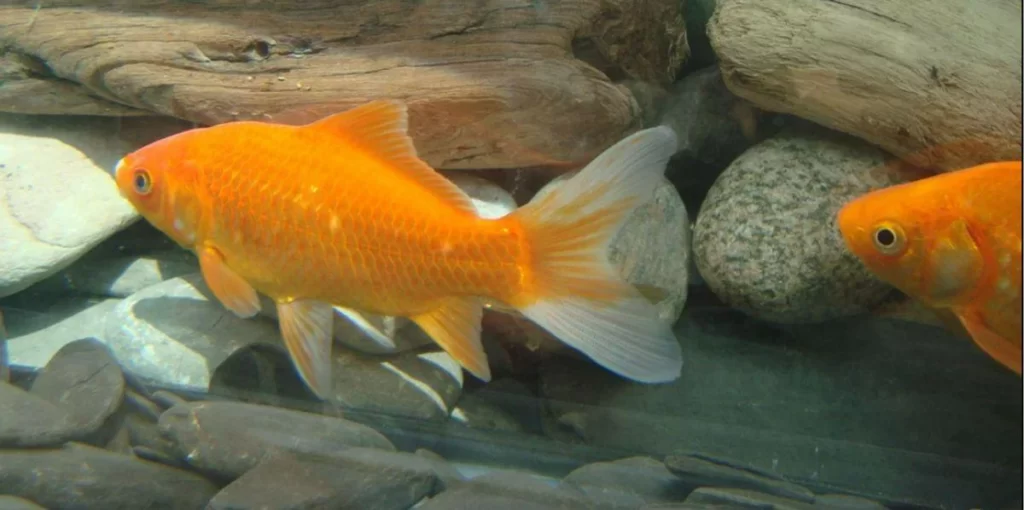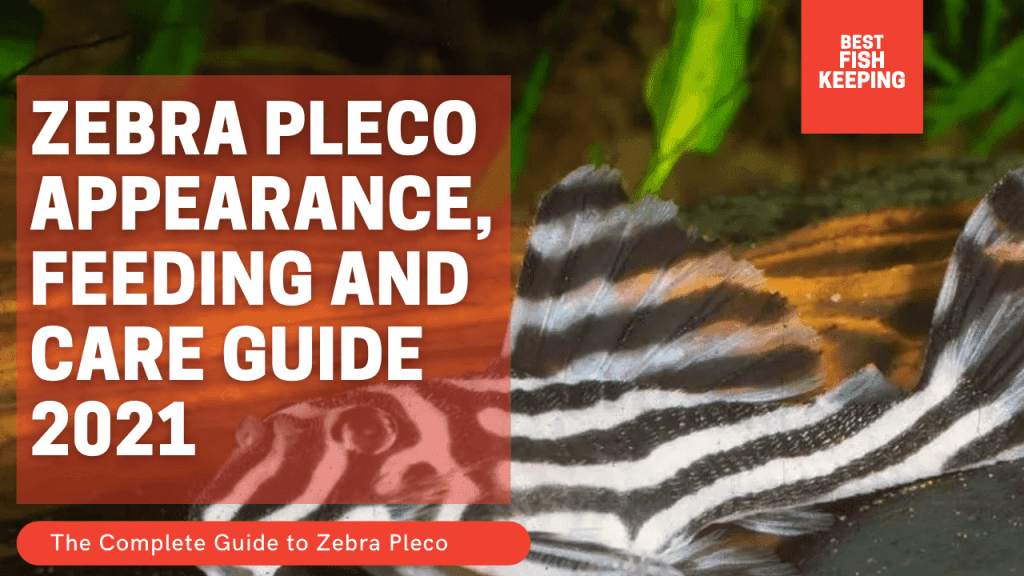
Choosing the right type of fish for your aquarium can sometimes be very difficult. In this article, we will discuss one of the species of fish, the pleco zebra. If you are looking for information about Zebra Pleco, you have come to the right place. We will talk about the catfish Zebra Pleco, also known as Zebra Plecostomus, whose scientific name is Hypancistrus Zebra. So continue reading to learn all the facts.
General information
This catfish is found in the Xingu River in Brazil. These species are a bit difficult to find, but you can still find some for your aquarium. Zebra Pleco has a long body and, as its name suggests, is colored like a zebra with black and white stripes. It has four whiskers around the mouth and quite large eyes. They are small species of fish that reach a size of 10 cm. Zebra Pleco has a shelf life of 15 years if you take good care of it.
Zebra Pleco General Specifications
Its scientific name: Hypancistrus Zebra
Often known as Zebra Pleco, Imperial Pleco, L46, L48
Lifespan: 10-15 years or more
Size: 3-4 inch
Diet: omnivorous, eats a wide variety of foods but prefers frozen/live foods. Supplement your diet with zucchini slices and similar vegetables.
Behavior: Maybe aggressive when only maintained by its species, but is generally peaceful with other species.
Care level: easy to medium
The pH value should be: 6.5 – 7.0
Water temperature: 26 to 30 ° C
Tank size: a minimum of 20 gallons of aquarium
Habitat: South America: zone of influence of the Xingu
Tankmates: You need peaceful tankmates.
Breeding / mating / reproduction: lays eggs
Zebra Pleco can be a unique and beautiful addition to any aquarium. While they can be a bit expensive than other aquarium fish, they are worth all the money. You need to take care of them during breeding, ensuring that the proper conditions are maintained in the tanks so that they do not become infected. And don’t forget to do the correct treatments. I hope this article is informative enough about zebra pleco aquarium fish.
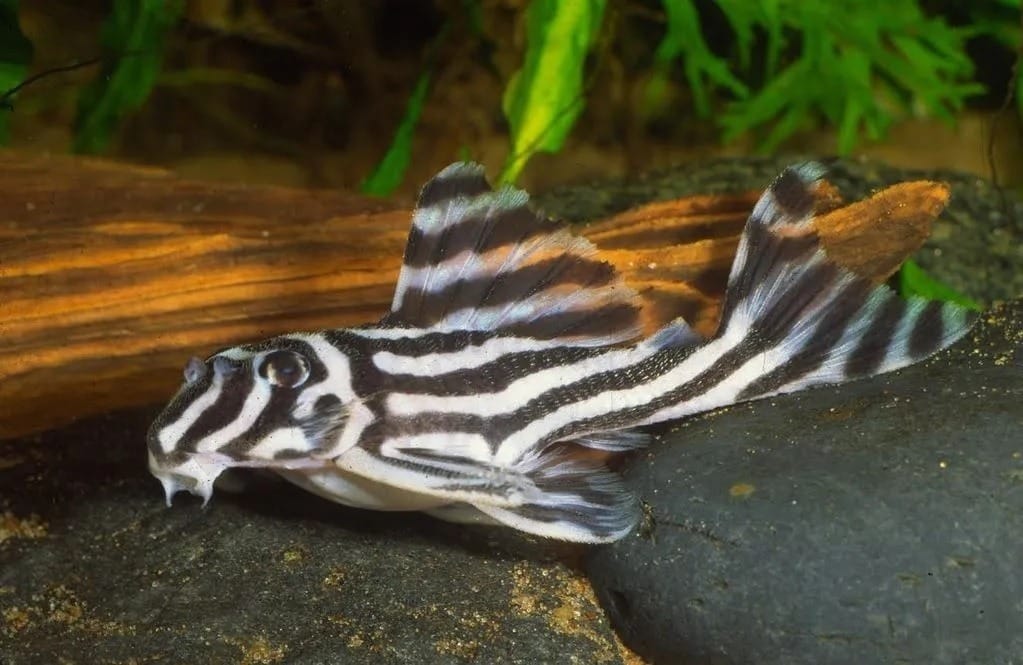
Appearance
When fully mature, Zebra Plecos reach a length of 7.6-10.2 cm. They are smaller than some of the other plecos, which could explain why they avoid crowds.
The most crucial aspect of its appearance is the black and white side stripe pattern that inspired its name. With ideal lighting, your stripes pop and shine and bring life and vibrancy to your community aquarium. The stripe pattern can also be seen on Zebra Pleco Fry.
In addition to those bright stripes, the Zebra Pleco has the expected suction mouth and other Plecos’ flat bottom. Of course, all four whiskers are catfish (they use them to explore their surroundings).
Small Mouth: Although these fish have the sucking mouth marking, it is essential to note that the Zebra Pleco has a much smaller mouth than other catfish, which will affect how you feed them. We will discuss this in the “Diet” section.
The pleco zebra’s large eyes also make it stand out from the crowd. These catfish have plenty of food for their fins: their dorsal fin is a triangle and is erect, but they can leave it when they want. On the side of their body, they also have two sets of pectoral fins and one set of striped fins that are quite large. 
Tank requirements for Zebra Pleco
It would help if you had at least a tank of 20 gallons for these fish, but larger tanks are also preferred. It would be best if you got excellent sand or gravel for the substrate from the aquarium. Also, the tank must have many places to hide. You should always change the water to keep it fresh and full of oxygen. The pH value in the Zebra Pleco tank should be between 6.5 and 7.5.
Feeding Zebra Pleco
To be healthy, Zebra Pleco must eat foods rich in protein. If you are looking for a fish that eats algae, this is not the fish you are looking for as Zebra Pleco does not eat algae. If this is your first time getting Zebra Pleco, you need to be careful about their diet as they are shy and avoid eating it. So you need to take care of it. These fish are omnivores.
You can feed them both frozen and live foods such as bloodworms and brine shrimp. However, it is better to provide them with live foods. Vegetables can be fed grated peas without the zucchini skin. Although they don’t eat a lot of seaweed, you can also give them seaweed waffles. It is recommended to feed Zebra Pleco 2-3 times a day.
Zebra Plecos are predatory fish, and they need a lot of protein. That being said, they are not very pushy when it comes to their food. Therefore, you must ensure that they do not compete with other, more aggressive fish than them. In this case, your Zebra Pleco will run out of food.
Since these fish are not aggressive eaters, choose a quiet spot in the aquarium to feed them. They’ll feel more confident and less stressed, and you can make sure they’re getting enough nutrition to make them look their best. Health.
Zebra Plecos eats more meat than other species of catfish. You will appreciate live bloodworms (although they will gladly accept frozen and lyophilized). They also like small invertebrates, and you should also provide them with protein-rich dry foods. Brined prawns are a popular choice from Zebra Pleco.
Although they eat seaweed and vegetables (try cucumber), protein is the staple of their diet. Also, remember that they have an incredibly small mouth and cannot handle overgrown greenery and veggies.
If you are using fish food, use granules instead of flakes, as these will hang to the bottom of the tank.

Zebra Pleco breed
It is a bit difficult to distinguish the male Zebra Pleco from a male. The only way to tell them apart is if male pleco zebra have larger heads than females. During reproduction, the female Pleco zebra carries eggs in her belly. Usually, this species during breeding during the rains season; this can be from July to September when in-state natural.

However, if they are kept in an aquarium, they can breed at any time. When they reproduce, the fish must have many hiding places in the tank. And you need to change the water in the tank frequently. For optimal reproduction, the tank’s temperature should be 28 ° C, and you should use suitable air pumps to increase the tank’s oxygen level.
Zebra Pleco lays about 15 eggs in a cave, and the male watches and fries the eggs. The eggs will begin to hatch in 3-7 days.
Lifespan
It takes a long time to care for a Zebra Pleco. However, these fish have a lifetime of 10 to 15 years in a well-maintained aquarium.
However, when it comes to life expectancy, there are no guarantees. This species, like any other freshwater fish, is prone to sickness and death.
In most situations, if they are kept in poor living circumstances or have limited access to high-quality meals, their lifetime is decreased. Therefore, if you want your Zebra Pleco to survive as long as possible, you must provide proper care.
Average Zebra Pleco Size
When fully developed, the Zebra Pleco is between 3 and 4 inches in length. So they’re a little smaller than other plecos, which might be a problem in a communal tank.
Behavior & Temperament
Zebra Plecos are timid and quiet. So it’s not unusual to find these fish hiding in caves to avoid the noise of other fish.
Because this is a nocturnal animal, don’t expect to see much during the day. However, their activity level skyrockets at night! They will search for food or explore the tank during this period.
With other fish of the same species, Zebra Plecos have been known to become territorial. This is particularly true for men. So if you’re housing men together, keep an eye on them to avoid fights.
Common Possible Diseases
Zebra Plecos are susceptible to all of the common freshwater fish illnesses. Ich, fungal infections, and bacterial infections are all examples of this. These are prone to bacterial and fungal diseases. Therefore, anti-bacterial treatments are used by many owners regularly.
This is not essential, though, if the tank is properly maintained. The majority of illnesses are caused directly by the inadequate living situation. To keep the water clean and healthy, invest in a good filter and replace around 20% water every week. Illness prevention is always preferable to disease treatment.
If your fish get an illness, isolate them and treat them appropriately. There are several over-the-counter medications accessible. Avoid copper-based goods! Copper sensitivity is higher in zebra plecos and other pleco species than in other fish.
Food & Diet
Now and again, you could see your Zebra Pleco eating aquarium algae. However, they do not enjoy it as much as other plecos or avid algae eaters. So don’t make the mistake of believing that these fish can only eat algae-based meals.
A high-protein diet is ideal for Zebra Plecos. Invest in dried foods that are high in protein. Also, choose sinking pellets rather than flakes since they are bottom feeders.
Live or freeze-dried foods can also be used. Brine shrimp and bloodworms are favorites of zebra plecos.
You can also supply algae wafers and blanched vegetables on occasion. Crushed peas and zucchini are favorites of this fish.
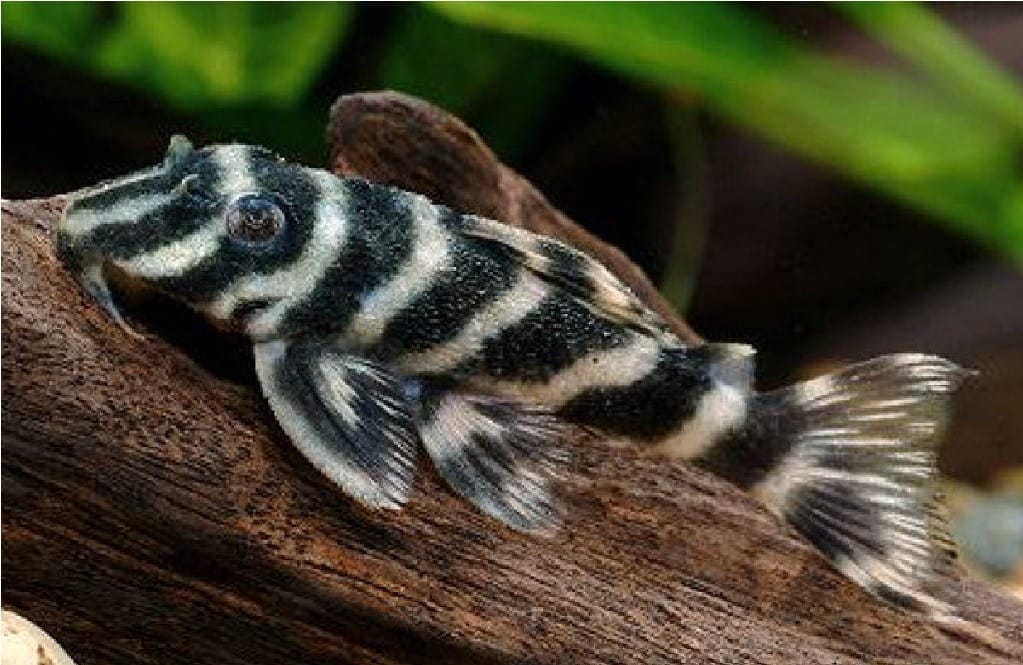
Tank Size
Let’s start with the aquarium’s size. Because these fish are tiny, they don’t require a large tank to be content. You should maintain them in a 20-gallon aquarium at the absolute least.
However, if at all feasible, we recommend getting a little bigger. For example, a 30-gallon tank allows for additional swimming space. You may also maintain them in a small group without having to worry about territory concerns.
Water Parameters
Simulating the waters of Rio Xingu is the greatest method to keep your Zebra Pleco happy and healthy. This isn’t limited to decorations. You’ll also need to mimic water conditions carefully!
Zebra Plecos prefer warmer waters with a neutral pH. Stress and illness can be caused by anything that is excessively alkaline or acidic. The good news is that the temperature, pH balance, and permissible hardness ranges are rather broad.
This ensures that the fish has some adaptive wriggle space. If you follow the guidelines below, you should have no trouble keeping your Zebra Pleco healthy.
- Temperature of the water: 79°F to 88°F (somewhere in the middle is best)
- Water Hardness: 2 to 6 KH
- pH: 6.5 to 7.0
When you initially introduce these fish to their new environment, it’s critical to keep a close eye on these levels. They might be sensitive to significant changes, so testing the water frequently can help you maintain things as consistent as possible.
Tankmates
You should keep them in groups of at least one man and several women. And the environment should be like Xingu. They can be controlled by other species and are not aggressive at all. However, if they are only kept with the same species as them, they will have territorial and aggressive problems.
To properly configure a house for Zebra Pleco; It is convenient to appreciate the natural habitat: they live in fast and highly oxygenated waters. So the first thing that comes to mind when setting up a tank is a more efficient powerhead filter.
Otherwise, the tank must be provided with a sandy base; on the contrary, you can use gravel. You should avoid using coarse sand or gravel to prevent injury to the abdomen. And so that I do not forget; The minimum tank size for storing Zebra Pleco is approximately 75 liters.
While the substrate can be exposed, don’t miss the opportunity to create lots of hiding places for them using PVC pipes, caves, or flower pots; be sure to provide items appropriate for the size of the fish.
You can also decorate the tank with stones, tree roots, driftwood, broad-leaved plants, or floating plants; These plants can help block sunlight.
Tank lighting should be down or entirely off. Better yet, it would be best if you made an effort to keep the tank in a place with minimal exposure to sunlight, possibly around the corner of the room.
Since high ammonia levels can adversely affect oxygen concentration, you should always check the engagement [with a kit] and keep it at 0 mg/ml. Another thing to keep in mind is that the oxygen concentration is generally lower at higher temperatures, so a working ventilation system [and filtration system] shouldn’t be missing from your tank setup.
Diseases Zebra Pleco may have
They are relatively healthy fish species, but they can sometimes get bacterial, parasitic, and fungal infections. To keep the fish healthy to keep, you need to undergo antibacterial treatments. To keep your fish healthy, you need to change 20% of the water every few weeks.
Occasionally, infections due to warts can occur. In this case, warts must be removed during the operation. In general, these fish do not have any health problems, but you have to be careful with their behavior. And don’t forget to give them all kinds of medications if necessary.
Is Zebra Pleco Right For Your Aquarium?
If you have a few extra bucks in your pocket and you want a display cap for your aquarium, Zebra Pleco is the place for you. The iconic stripe pattern and nightly antics will captivate you.
If you’re up to the task of managing a new aquarium with a strong current to keep your Zebra Pleco happy and healthy, this catfish could be for you.
And if you already host other non-aggressive fish and want to expand your flock, Zebra Pleco is the right choice for your community aquarium.
Frequently asked questions
Seaweed can be part of Zebra Pleco’s diet, but most of Zebra Pleco’s diet should be protein. They are carnivores and predators (although it must be recognized that they are not aggressive eaters). You need fresh, frozen, and freeze-dried protein sources to stay healthy.
They have a particular preference for bloodworms and also like brine shrimp and other small invertebrates.
If you’re looking for green springs, they also like cucumber, mushy peas, and zucchini, but that’s the page too; Protein should be the main dish.
The most important thing about food choices for Zebra Plecos is that they have an incredible smallmouth and therefore cannot handle large pieces.
No, you don’t need a separate breeding tank. We don’t recommend moving zebra plecos at all (unless they are sick and you need to quarantine them). If you want to encourage breeding, raise the aquarium temperature to 82 °. F (27.8 ° C) increases oxygen flow by adding airfields, additional filters, or a powerhead.
The increase in temperature and oxygen causes the female to produce eggs. Zebra Plecos need a burrow for the breeding process (the female lays the eggs in the shelter, and the male fertilizes the eggs and cares for them), but if you have Zebra Plecos in your aquarium, you already have holes.
You like to make sure that the small fish are protected from other fish after the eggs hatch and given enough food, so make sure they have their own space in the tank.
Plus, if you’re hosting 15 new Zebra Pleco Roasts, you’ll want to make sure your tank is big enough to hold them all.
What great news that you are starting your love of fishing! We know you will find it rewarding and enjoyable. Zebra Plecos won’t be our first choice if you’re starting. Certain tank conditions must be followed, which can be more difficult for a beginner: they need a strong current like their home country, Rio Xingu, in Brazil. You will also need a carefully maintained tank and frequent water changes. If you are a newbie and want to start with this beautiful catfish, we recommend starting with one in a non-communal aquarium.
How long have Zebra Pleco been in their eggs?
